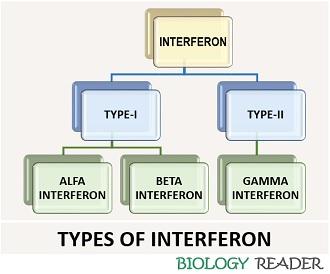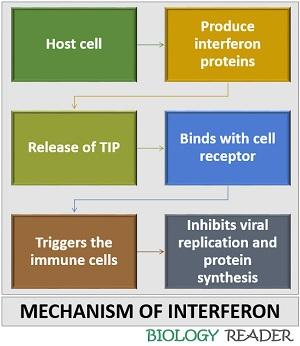Interferons are the antiviral proteins that inhibit both the transcription and translation of the viral genome. It was first studied by the two scientists named Isaac and Lindenmann in the year 1957, while they experimented on the chick chorioallantoic membrane fragments with the live influenza virus. On experiment, Isaac and Lindenmann found that the interaction of the host cell and virus produced some diffusible antiviral substance.
Later, the antiviral substance named “Interferons” as they interfere with the replication of the viral genome and makes the cell impervious against the viral infection. Interferons also deal with the bacterial and parasitic attack, by inhibiting cell division and promoting cell differentiation.
Content: Interferons
Definition of Interferons
Interferons can define as the signal proteins released by a host cell when it interacts with a viral or other pathogenic complexes to defend itself and the neighbouring cells. These acts as an antiviral substance that renders a cell from viral or other pathogenic infections. Thus, interferon builds a natural defence mechanism inside a host cell. Interferon mediates inter or intra-cellular defence, where the one cell passes a signal to the other cell via TLR (toll-like receptors). TLR receives a signal generated by the host cell and gives the information to the immunogenic cells.
Types of Interferons
Based on the origin of the cell, interferons can classify primarily into three types:

Alfa Interferon: It abbreviates as IFN-α. Formerly, it was known as “Leucocytes interferons”, produced by the leucocyte cells. About 16 antigenic types of IFN-α have been identified till now. It is composed of non-glycosylated protein.
Beta Interferon: It abbreviates as IFN-β. Formerly, it was known as “Fibroblast interferons”, produced by the fibroblast cells. It is composed of glycoprotein molecules.
Gamma Interferon: It abbreviates as IFN-γ. Formerly, it was known as “immune interferons”, produced by the T-lymphocyte cells. It is also composed of glycoprotein molecules but differs from the IFN-α and IFN-β, by having an additional cell receptor.
| Properties | Alfa Interferon | Beta Interferon | Gamma Interferon |
|---|---|---|---|
| Producing cell | Leucocytes | Fibroblast | T-lymphocyte |
| Amino acid sequence | 167 | 166 | 143 |
| Molecular weight | 19.5kDa | >20kDa | 17kDa |
| Quaternary structure | Contains five α-helices | Contains five α-helices | Contains six α-helices |
Based on antigenic properties, interferons broadly classify into type-I and II.
Type-I: The function of IFN-α and IFN-β is to provide resistance against the viral attack, and due to this property, these two are classified into type-I interferons. Both IFN-α and IFN-β have a similar sequence of amino acid.
Type-II: The function of IFN-γ is to provide overall immune resistance in counter to any viral attack, and thus classified into type-II interferons.
| Properties | Type-I interferons | Type-II interferons |
|---|---|---|
| Producing cells | All nucleated cells like leucocytes, macrophages, monocytes etc. | Specialized cells like T-cells, B-cells, NK cells and APCs |
| Responding cells | All nucleoid cells | All nucleoid cells |
| Acid stability | Stable | Unstable |
| Peptide chain | Monomeric | Dimeric |
| Functions | Functions as antiviral, antiproliferative and immunoregulatory agents | Functions as antiviral, antiproliferative, anticancerous and immunomodulatory agents |
Characteristics of Interferon
Interferons share the following features:
- It belongs to the class “Cytokines” and discovered the earliest of cytokines.
- The activity of proteolytic enzymes inactivates the interferon stimulation.
- Enzymes like lipases and nucleases do not affect the activity of interferon significantly.
- Interferons are the kind of proteins that are resistant to heating at a temperature of 56 to 60 degrees Celsius for 30-60minutes.
- All the IFNs are stable at a pH (2-10), except IFN-γ.
- The molecular weight of interferon is about 17,000Da.
- Interferons are the natural protein molecules secreted inside the cell, which are non-dialyzable, non-sedimentable and poorly antigenic.
- Its potential to trigger the immune system is measured in international unit per ml.
Mechanism of Action
Interferons are the secretary proteins produced by the host cell in response to any attack by the foreign body or extracellular stimuli. Then the IFN proteins will go into the bloodstream and attaches to the specific receptor of the neighbouring cells.

By the interaction of IFN with the cell, the receptor will produce TIP or translation inhibiting the protein. The TIP proteins will act as antiviral molecules that will block the translation of viral mRNA into viral proteins.
Therefore the interferon works by a mechanism of inter or intracellular networking that triggers the immune system to regulate an acquired and innate immunity against antigenic particles.
Clinical Applications
Interferons are extensively used in the form of medicines that are produced commercially by the recombinant DNA technology. On study, it was found that the interferons from a human source are clinically reliable, whereas IFN isolated from a non-human source is not clinically significant. Interferon is used clinically because of its following ideal properties:
- Non-toxic
- Non-antigenic
- Freely diffusible inside a body.
Interferons are used to treat not the infections caused by viruses, bacteria, fungi etc. but also used to treat tumour cells. The functional role of interferons in a human cell are as follows:
IFN-α: It is effective against cancer and viral infections.
IFN-β: It is effective against multiple sclerosis.
IFN-γ: It is effective against the chronic granulomatous disease.
Important Facts
IFN-α was the first interferon to be approved by the FDA as a viable therapy for the treatment of hairy-cell leukaemia. In the year 1988, IFN-α was approved for the treatment of genital warts with an efficiency of 70%. Later, it was also found effective to treat Kaposi’s sarcoma, a type of cancer. Then, in the year 1991, IFN-α showed reliable results in the treatment of hepatitis-C. The FDA secondly approved IFN-γ for the treatment of multiple sclerosis, chronic granulomatous disease, leishmaniosis etc.
Apart from IFN-α, IFN-β and IFN-γ, there are two other classes like IFN-Ω and IFN-τ, that have also been discovered. On further study, tau interferon proved to be effective in promoting pregnancy of cows, sheep etc. Like other interferons, it also shows antiviral property, blocks tumour cell division and may also interfere with the replication of HIV. In some cases, tau interferon showed some side effects like:
- Flu-like symptoms
- Decreases in blood cell count
- Necrosis
- Anaphylaxis
- Changes in the menstrual cycle
Interferons are now extensively used as medical science to treat viral, bacterial, fungal, parasitic infections and the cancer cells.